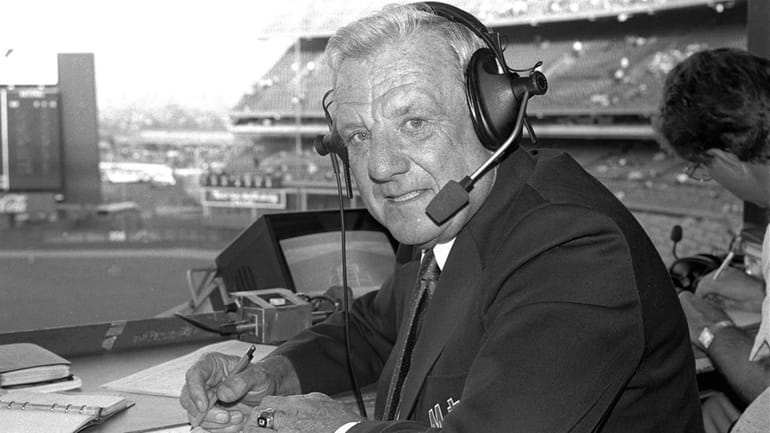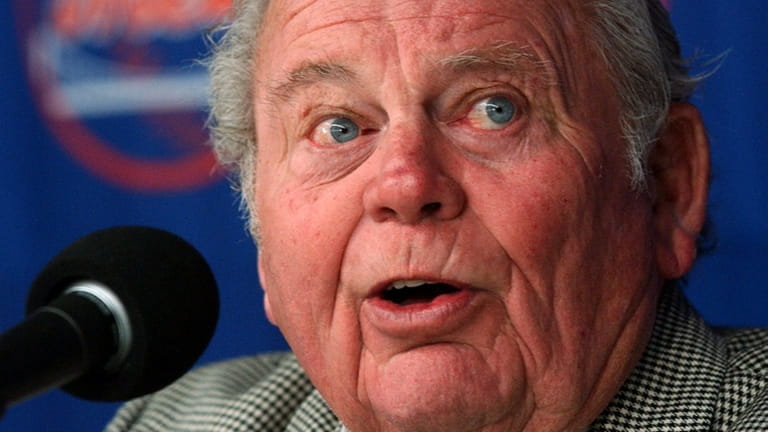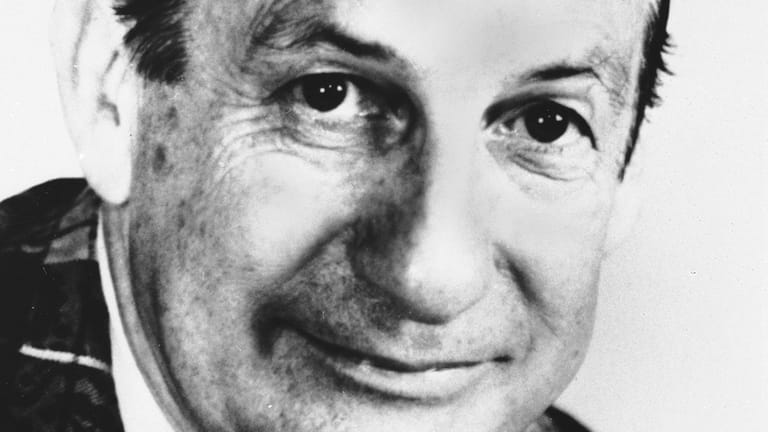Remembering the Mets' original TV broadcast team of Bob Murphy, Lindsey Nelson and Ralph Kiner

Hall of Famer Ralph Kiner sits at Shea Stadium on May 10,1985. Credit: AP/RON FREHM
There was no way of knowing when SNY assembled its first Mets booth for 2006 that it still would be intact 17 seasons later, tying a record set by the original announcing team of Bob Murphy, Lindsey Nelson and Ralph Kiner.
But Gary Cohen, Keith Hernandez and Ron Darling had something going for them that their predecessors did not: familiarity, in the form of a longtime Mets radio announcer and two members of the 1986 championship team.
“This is really hard to fathom if you are a Mets fans in their 60th anniversary season, but they were creating a product from scratch,” Cohen said. “They didn’t have former Mets to bring in, because there was no such thing.”
So the Mets and their media outlets turned to Nelson, a national announcer known mostly for college football; Murphy, an experienced baseball play-by-play man for the Red Sox and Orioles; and Kiner, a seven-time home run champion with the Pirates who was familiar to National League fans.

Mets broadcaster Bob Murphy announces his retirement after 42 seasons at Shea Stadium on Sept. 25, 2003. Credit: NEWSDAY/Jiro Ose
“When you think about that mix, it was inspired on every level,” Cohen said, “because you had three completely different sounds, three people with a different experience. And as we know, it was the perfect combination for that fledgling team.”
Well, so it seemed for young fans, such as Cohen, now 63, Mets radio announcer Howie Rose, 68, and other Baby Boomers who grew up with the original announcers and knew nothing else.
Grownups initially were less impressed. After the home opener in 1962, The New York Times TV critic Jack Gould wrote, “A workmanlike team, if not one likely to give baseball commentary the lift it could use.”
Jack Mann of Newsday mostly was positive after the opener but took a few shots at Murphy, whom he called “the mop-up announcer.” (Nelson, Murphy and Kiner rotated through both TV and radio booths in those days.)
But over time, the trio came to be the sound of the Mets, and when seven seasons of futility gave way to the “miracle” of 1969, the upstart franchise had voices to call its own and a generation forever bonded with them.

Sports announcer Lindsey Nelson is shown in 1977. Credit: AP
“When I heard their voices, it was a good feeling, regardless of what the Mets were doing,” Rose said. “It felt like I was with my uncles.”
Nelson left the Mets for the Giants in 1979, breaking up the original trio, and died in 1995. Murphy retired from the Mets radio booth after the 2003 season and died in 2004. Kiner made occasional appearances on SNY until 2013 and died in 2014.
Fans under age 50 or so have no memory of listening to them work together live. Those over 50 never will forget.
“They were the ubiquitous sound of the Mets,” Cohen said. “They were on my radio or TV every day for six months.”
Said Rose, “I became almost umbilically connected to them . . . They were in my eyes and ears for the better part of seven months, including spring training. So it does become an almost familial connection.”
It was a different time in sports announcing, lacking in deep analysis – and questioning of managers’ strategy. Tim McCarver helped usher in the modern era with his more critical approach on Mets broadcasts in the 1980s.
But the originals carved distinctive brands for themselves.
“Lindsey was the very fast-talking and eccentrically dressed announcer,” Cohen said. “Murphy had wonderful, lilting, cadences and expressions. Kiner knew the game and had this incredibly gentle way of expressing himself. They were wonderful personalities.”
Neither Cohen nor Rose knew Nelson well, but both worked with and knew Murphy and Kiner. So unlike most of their fellow fans of the 1960s, they found themselves alongside their childhood narrators as adults.
“Surreal,” Rose said. “I can’t find a better word than that.”
Rose said that he often thinks about being a 15-year-old following every pitch for the Mets “on their way to this improbable, phenomenal, everlasting ecstasy” in 1969 by listening to Nelson, Murphy and Kiner.
“If you would have told me back then I would be working on television with Ralph and on radio occasionally with Bob,” Rose said, “I’d have said the odds against that must have been beyond anybody’s ability to comprehend.”
Cohen said that when he joined the Mets radio team in 1989 after working in the minor leagues, he realized how much his style had been influenced by his now-partner, Murphy.
“It rubbed off on me by osmosis without me even having a clue about it,” he said. “It wasn’t until I sat next to him every day that I realized so much of what I had developed as a style was a tribute to what I’d learned from Murph.”
From left, Mets television broadcasters Keith Hernandez, Gary Cohen and Ron Darling prepare to work a game against the Giants at Citi Field on June 4, 2019. Credit: Jim McIsaac
Those voices of the past now echo mostly in fans’ memories and on old highlights, and come 2023 their record 17 seasons is set to be surpassed. Now Mets fans under 25 or so do not remember a world without Cohen, Darling and Hernandez on SNY.
“We’ve just been so incredibly blessed to live out a dream this way,” said Cohen, entering his 34th season on Mets radio or TV, “and to walk in those enormous footsteps.”
Rose said when someone tells him he is “this generation’s Bob Murphy,” it resonates.
“It absolutely blows my mind,” he said. “There is no greater compliment that anybody can give me about my work with the Mets than to say that I represent to them what Lindsey, Bob and Ralph represented to me.”

